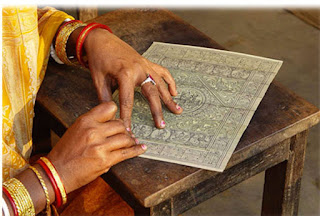In my last blog I talked about History of Pattachitra Painting, It was so interesting that in order to know more about it I insisted dilli haat painter to take me a look of his worksite .Where I noticed tools which are used to make Pattachita painting. Then he introduced me to most important tools which are used to make pattachita painting which are, Rubbing stones – “khaddar stone and Chikna stone”,Treated cotton cloth or Patas, Brushes, and Lacquer and they also have pencil and eraser.
 |
| Process of sketching on canvas |
Then he told me about use of tools in painting, HB pencils to draw rough sketches and drawings on the canvas.They use two type of Rubbing Stones, one of them is Khaddar stone which is used for smoothening and another one is Chikna stone which is used for shine on the canvas on which, paintings have done.
Then he showed me canvas, when I touched it, it seemed like paper.Then I asked him "Is it a paper?..if yes..what is special about it?" He smiled on our innocence and said "no ma'am" then he continued that the canvas is specially prepared from cotton cloth, which is coated with a mixture of gum and chalk and polished, before applying natural colours. The process begins with creating a canvas, or the surface on which the painting is to be executed. A gummy paste of boiled tamarind(Imli) seeds and soft granite powder is plastered on a stretched piece of cloth, twice over, so that it becomes stone hard and does not crack.
This is time consuming process, this process is known as ‘NiryasKalpa’. I asked him,"How much time?" He said"min. 5 days." The moment he told me that minimum time required for preparing canvas is 5 days..I am like what.?? 5 days. Then I realised that each and every material they use are very special that is the one of the reason to make this painting special.They also have same other bases on which the Pattachitras are done which are tussar silk and wood.
And yeah how can I forgot about the most important tools which are colour & brush as no painting can be created without these tools. In an artical I comes to know about, the speciality of brush which is used by painters ,is that they are of animal hair and plant fibers. These includes mongoose or mouse hair for fine tip, fixed over a bamboo or wooden handle.The coarser brushes are made from the hair of the buffalo neck. “Kiya” plant is popularly used to make brushes of various thickness.
 |
| Finest tip of brush are used to highlight outline |
While I was searching about colour I got to know that the materials used in the paint are from vegetable, earth, and mineral sources. Black is made out of lampblack, yellow from haritali stone, and red from hingal stone. White is prepared from crushed, boiled, and filtered shells.
 |
| colours used in painting |
After painting gets ready, painters use Lacquers (made from resin seeds) which gives lovely shine to the painting. This process is known as “Jaulasa”.
References:
1.http://www.dsource.in/resource/patachitra-painting-orissa/tools-and-materials
2.http://artycraftyarena.blogspot.in/2009/10/tanjore-paintings-and-steps-make-them.html
3.http://puzzledesh.com/inspiration/
source of image: http://www.dsource.in/resource/patachitra-painting-orissa/tools-and-materials
https://www.google.co.in/search/colour+used+in+pattchitra





















